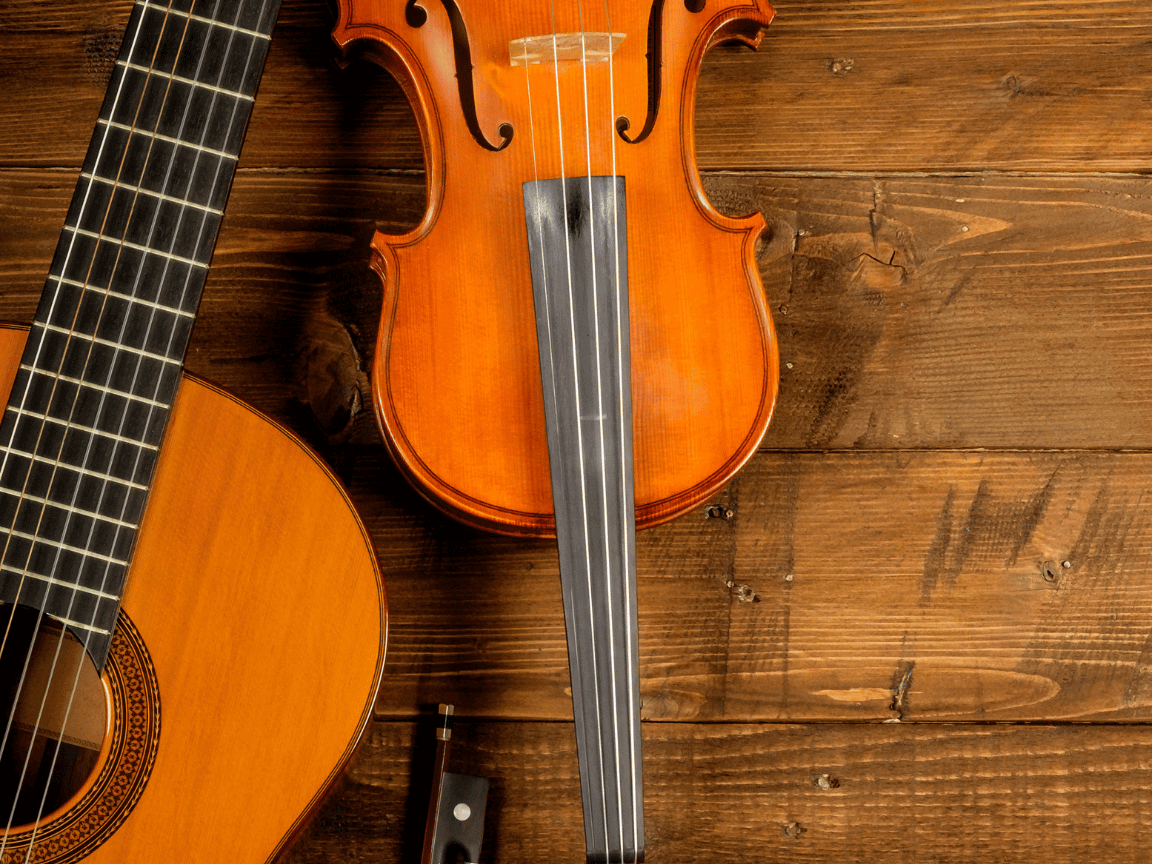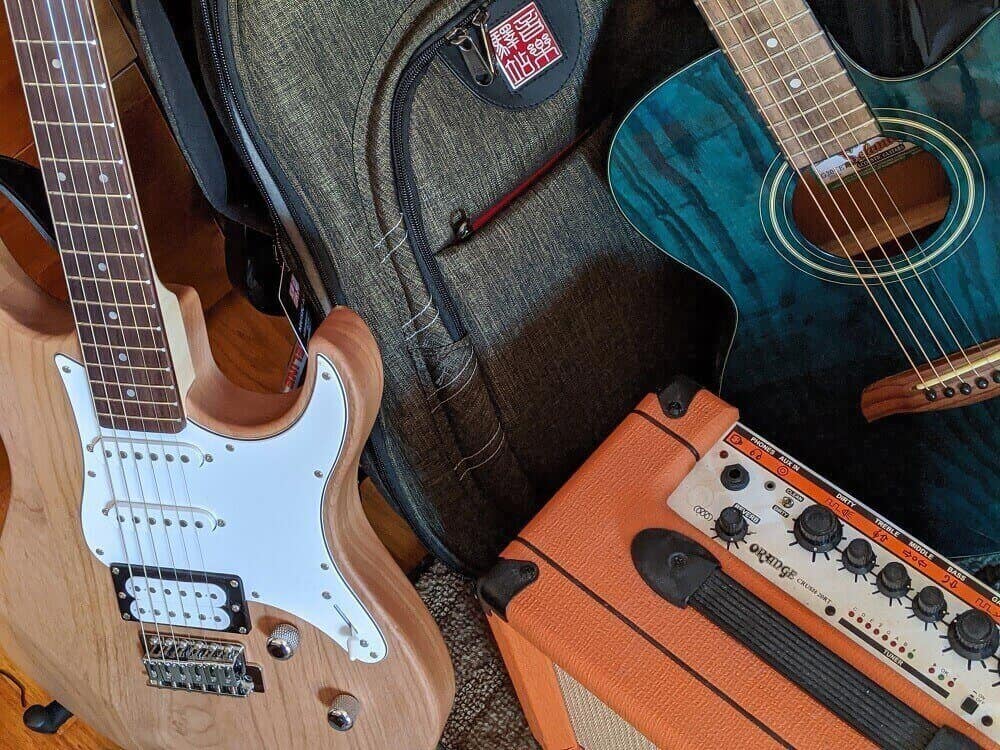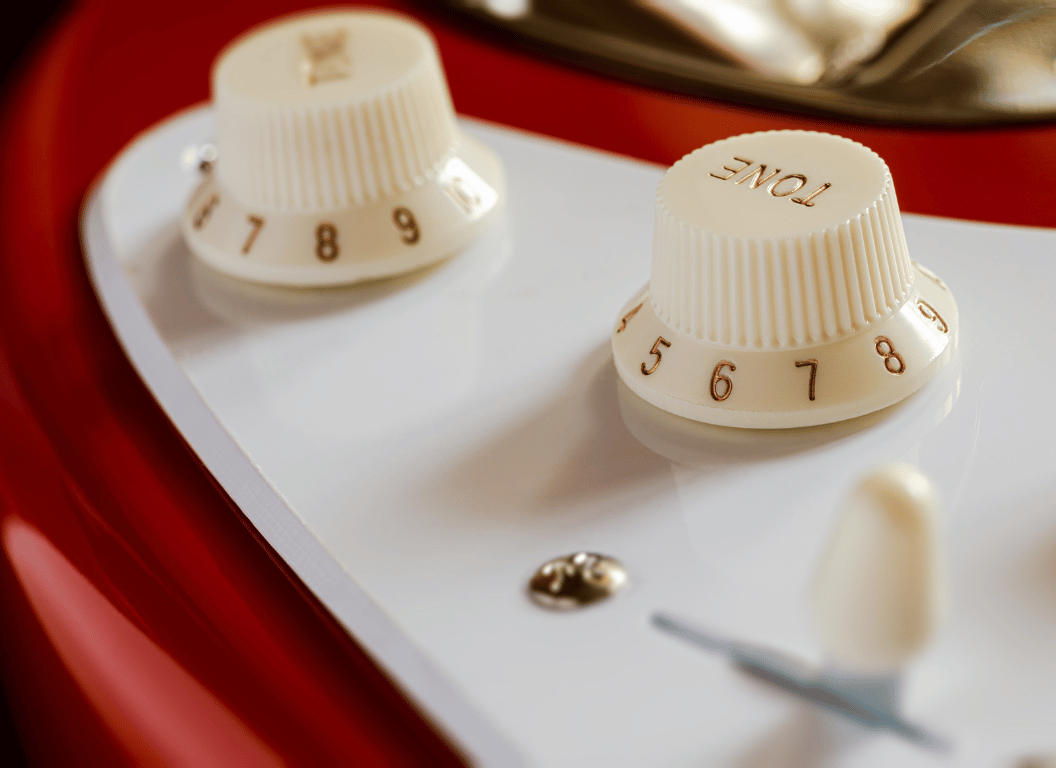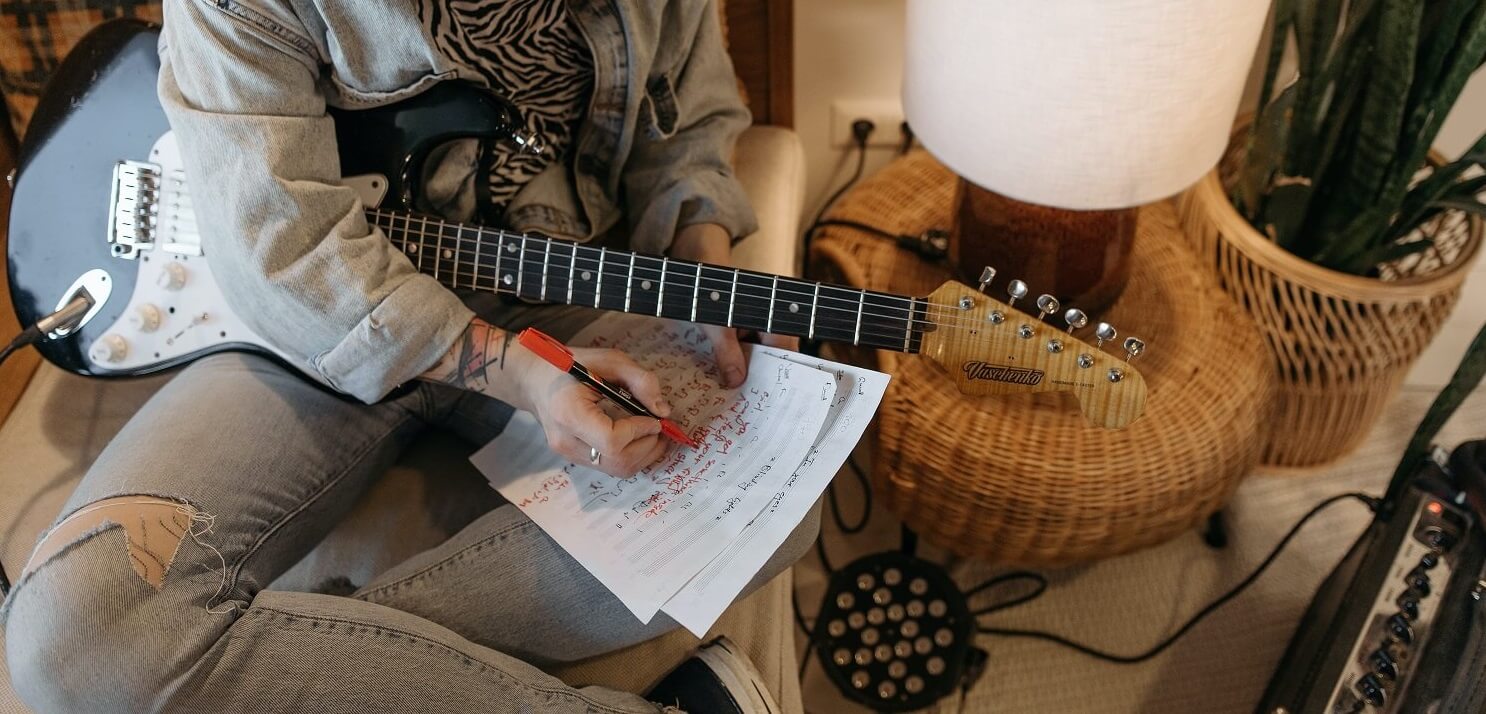In the realm of musical instrument playability, there are countless explorations and unorthodox approaches.
A question often raised involves the feasibility of playing a guitar with a bow, in a manner similar to how one would play a violin.
This endeavor challenges the conventional boundaries of guitar performance.
In this article, we will dissect this idea, examining practical aspects as well as potential limitations.
We’ll delve into historical attempts, techniques involved, and the sonic outcome of such practice.
Is it merely whimsical curiosity or a viable, uncharted territory of music waiting to be discovered?
Table of Contents
- Can You Play A Guitar With A Bow Like A Violin?
- Basic Differences Between a Guitar and a Violin
- How to Bow Play the Guitar?
- Equipment Required to Bow Play a Guitar
- Challenges You Might Have when Bow Playing a Guitar
- Famous Musicians Playing the Guitar with a Bow
- The Impact of Guitar and Bow Types on Sound Effects
- Guitar Sound: Played with Hands vs. Bowed
- The Bottom Line
Can You Play A Guitar With A Bow Like A Violin?
Yes, it is technically possible to play a guitar with a bow like a violin. However, the differing structures and designs of the two instruments may produce varied sound effects. Extended techniques, such as bowing, might require specific skills or equipment to effectively produce a desirable sound.
Digging deeper into this matter, we will expand on the technical nuances and potential challenges that come with using a bow to play a guitar.
It’s not simply a matter of switching tools; understanding the complexities involved can help enthusiasts and aspiring musicians appreciate the art and skill involved in such a unique approach.
Our discussion will also delve into the historical instances of bowing techniques used in guitar playing and the potential for innovation in this field.
So read on, as we tackle the diverse influences and the key role that experimentation plays in music creation.
Basic Differences Between a Guitar and a Violin
When it comes to musical instruments, the subtle and not-so-subtle differences are what gives each its unique sound.
Yet, even among instruments that might seem similar such as the guitar and violin, there are some key differences that create vastly different musical expressions.
– Differences in Construction
For one, the construction of a guitar and violin is different.
The guitar is typically larger and built to be held on the lap or with a strap around the neck.
The body of the guitar is also hollow, designed to produce sound that is resonant and echoing.
On the other hand, the violin is designed to be held on the shoulder and is smaller in size.
Despite being smaller, its body is made to be highly resonant, with a loud and clear output even without amplification.
– Strings and Tuning
Variations in tuning and the number of strings on a guitar and violin greatly influence their musical capabilities.
The standard guitar has six strings, while a violin has only four.
Tuning each of these strings also differs vastly, with guitars generally being tuned in fourths and violins being tuned in fifths.
This difference in tuning leads to a unique range of notes and chords distinct to each instrument.
Variations in string materials also effect the sound produced, with nylon or steel strings often used for guitars, and horsehair for violins.
– The Playing Technique
How you play these instruments makes a significant difference as well.
A guitar is typically played with a pick or fingers, by plucking or strumming the strings.
In contrast, a violin is played with a bow, with the friction it creates against the strings producing a unique set of overtones and tones.
This key difference contributes to the distinct sound and articulation unique to each instrument.
Skillful manipulation of the bow allows violinists to create varying degrees of volume, sustain, and intonation.
– The Role of Frets
Another contrasting feature is the use of frets.
Guitars have frets which are raised metal strips placed along the fingerboard to indicate where to put your fingers to produce specific notes.
Violins, on the other hand, do not have frets, requiring a much greater deal of precision to hit the right notes.
Finally, it’s worth noting that the repertoire and scope of music for guitars is far more extensive, featuring prominently in a wide range of genres from rock to jazz to country.
Violins are generally more associated with classical music, although they have also found their place in various other genres.
While these are some of the fundamental differences between a guitar and violin, there’s one intriguing crossover technique that musicians have experimented with: playing the guitar with a bow.
It’s an unusual merger of the guitar’s resonance and the violin’s unique method of sound production.
Interested in what this sounds like? Let’s take a look at the following video:
By watching it, you’ll have a chance to hear exactly how a bow can create such a distinct sound when played against the strings of a guitar.
How to Bow Play the Guitar?
Playing the guitar with a bow opens up new textures and possibilities for musicians.
This unconventional methodology, though rarely employed, is a fascinating avenue for sound creation and brings a unique charm to sonic experimentation.
– The Initial Setup
To start bowing a guitar, the player should first adjust the guitar’s strings slightly higher than usual.
This creates a small gap between the strings to facilitate smooth manipulation with the bow.
Furthermore, adapting the holding position can make the technique easier.
A violin-like position, with the guitar body placed on the shoulder, will give a better angle for the bow to slide across the strings.
Adjusting the strings of the guitar to sit slightly higher and adapting the holding position for a violin-like hold can significantly enhance the ease of bowing.
This peculiar setup is instrumental to a more effortless bowing process, making way for a seamless transition between the strings and enabling the creation of continuous, unbroken sounds.
– The Bowing Technique
The bow should be drawn across the strings parallel to the bridge, not perpendicular to the strings like in traditional guitar playing.
This orientation ensures a constant pressure necessary for the sweeping gestures often associated with bowed instruments.
It’s also crucial to pay attention to the speed and the pressure of the bow against the strings.
These play a massive role in the produced sound, with faster motions and increased pressure often resulting in louder volumes and more intensity.
Experimenting with bowing different strings and varying pressure and speed can result in a plethora of unique sounds, reminiscent of a violin, but with the characteristically rich undertones of a guitar.
To get a better idea of how bowing the guitar could look and sound like in practice, take a look at a musician demonstrating this technique:
Watching the video, you can witness how to hold the guitar and manipulate the bow for optimal sound.
Additionally, you can see how varying the bow’s motion and pressure affects the output.
– Additional Factors to Consider
Gauging the tension on the bow is another factor that could significantly impact the end result of this technique.
Different tensions can change the quality of sound – higher tension generally creates crisper, more resonant sounds, while lower tension yields a softer, more mellow output.
Lastly, maintaining the bow’s hair with an ample amount of rosin can ensure a constant grip on the guitar strings, leading to sustained and consistent sounds.
Different bow tensions and amounts of rosin can greatly influence the sound, enabling a spectrum of sonic possibilities.
These adjustments, though sounding time-consuming and complex, are at the heart of understanding and practicing the art of bowing the guitar proficiently.
They provide room for exploration, encouraging players to find the sweet spot that unleashes the richest, most satisfying sounds.
Several musicians have ventured into this unconventional territory, reinforcing the fact that guitars can indeed be played with a bow.
One of the most famous instances is Jimmy Page of Led Zeppelin, who incorporated bowing techniques into his live performances, creating mesmerizing, orchestral sounds from his electric guitar.
This fusion of guitar and violin playing techniques exemplifies instrumental versatility and the exploration of novel sonic landscapes.
Indeed, the rich, continuous sound produced by bowing a guitar provides an exciting contrast to the distinct, crisp notes generated by the traditional plucking technique.
So, ultimately, a guitar can be played like a violin, and doing so opens a wide realm of sonic possibilities.
For those wanting to see how he managed to play his guitar with an actual violin bow, then this video is the one you’re looking for.
Most of the time he used the bow to play some of his solos, and I’d say to add some entertainment to the performance.
Equipment Required to Bow Play a Guitar
When embarking on the journey of bowing a guitar, the first and foremost requirement is indeed the bow itself.
Traditionally, a guitar bow is borrowed from a violin or a cello because of their convenient size and effectiveness.
– Choosing the Right Bow
Choosing the right bow is quintessential for bowing a guitar.
All bows may look alike but when it comes to their functionality, they exhibit significant variation in their properties.
Important factors such as tautness, the curve in the bow, the type of hair used, and other minute details can significantly influence the sounds produced from bowing a guitar.
Supporting this assertion, it must be noted that the tautness or looseness of a bow affects the dynamics and responsiveness of the bow on the strings.
Likewise, a bow’s curve or camber controls its balance and flexibility.
A stiffer bow might be necessary while bowing thicker guitar strings for more control and sustention, on the flip side, a more flexible bow may be more suitable to bow thinner strings.
– The Guitar, Strings and Pickups
Rosin, which is applied to the bow hairs to increase friction with strings, is another to consider item.
In the case of a guitar, a different kind of rosin could be used considering the variation in the properties of the strings as compared to a violin or cello.
Guitar strings and their type play a crucial role in bowing.
Unlike bowed instruments, guitars aren’t typically strung with gut or synthetic core strings; they usually have steel wound or nylon strings.
So, a bow optimized with guitar-specific rosin could facilitate better friction and, thereby, a clearer and richer tone.
At the same time, the specific type of guitar, electric or acoustic, might require different arrangements.
An electric guitar might need a unique kind of pickup that can better capture the nuances of the bowed sounds.
– Additional Accessories
Considering the unique physicality of bowing a guitar, certain adjustments like placing a bowed psaltery bow guard between strings may assist in isolating them.
Investing in a good quality practice mute can also control volume, especially while practicing in non-ideal environments.
While the equipment required to bow play a guitar might seem easily available and simple, the fine-tuning of these equipment and accessories can significantly impact the end results.
Therefore, to successfully bow play a guitar, one does not just need a bow and a guitar but a complex interplay of various factors that ensure an optimal sound output.
Challenges You Might Have when Bow Playing a Guitar
Broaching the unique exploration of playing a guitar with a bow brings forth a set of intriguing challenges.
These obstacles originate from the specific structural and sound production differences between guitars and bowed instruments.
– Physical Structure-Related Challenges
Firstly, we delve into the issues relating to the physical structure of a guitar.
Unlike violins and other bowed instruments, guitars are designed with frets.
Bowed instruments utilize a smooth fingerboard without frets and this greatly impacts the ease with which a bow can run across the strings.
Objects called frets are present on the guitar’s neck and are metallic ridges that section off the guitar’s fingerboard into a series of predefined note pitches.
Attempting to play a guitar with a bow on a fretted instrument can produce a jarring sound, unlike the continuous slide on a violin string.
Fretting a note on a guitar places a halt on the vibration of the much-needed string, and thus inhibits the smooth, continuous pitch-shift that is characteristic on a violin.
Observably, this limitation also impacts the progression of notes, limiting the player to a discrete note progression rather than a continuous, smooth change between notes which is achievable on a violin.
– Sound Amplification Challenges
The second major issue arises from the method of sound amplification in guitars.
Guitars – especially electric ones – are designed primarily to be plucked or strummed, and their amplification is built around this concept.
In contrast, bowing a guitar necessitates a different set of sound amplification mechanics that a guitar might not effectively support, thereby leading to a less-than-optimum sound output.
When a guitar is played with a bow, the vibration amplitude might not be picked up optimally by the guitar’s amplification mechanism, leading to subdued sound output.
This issue is more pronounced in guitars with electromagnetic pickups, as the vibration amplitude picked up by the pickups might be considerably lower when the guitar is bowed compared to when it’s plucked.
The video above demonstrates the differences when bowing versus plucking a guitar.
Watching it will provide an auditory experience, offering a more subjective understanding of the challenges involved.
– Physical Handling and Technique Challenges
A third challenge involves the physical handling and technique required to bow a guitar.
Considering guitar’s size and playing position, it can be physically awkward and uncomfortable to play a guitar with a bow when compared to holding it in a traditional guitar-playing manner.
Mastering the bowing technique on a guitar can present a significant challenge, considering the size, structure, and traditional position during playing.
Practicing to surmount this problem could lead to strain and discomfort, and the player must often compromise on either comfort or sound quality.
Therefore, a guitarist aiming to bow-play the guitar must be ready to put in significant effort to overcome these challenges.
Although it might not be the approach guitar was initially designed for, bold attempts to bow-play the guitar have produced unique sonic experiences.
It comes with its own set of difficulties, but for those willing to brave these challenges, a new realm of guitar playing awaits to be discovered.
Famous Musicians Playing the Guitar with a Bow
The technique of bowing a guitar, although not widely known or practiced, has been featured in the works of several notable musicians throughout history.
Jimmy Page, the iconic guitarist of the rock band Led Zeppelin, is famously associated with this technique.
– Jimmy Page’s Influence
Page first utilized the bow in 1967 during a live performance of “Dazed and Confused”.
His innovative approach captivated audiences and left an indelible mark on rock history.
During these performances, Page would often use a cello bow to achieve unique, ethereal sound effects on his guitar.
This opened up a new realm of possibilities in rock music, demonstrating that the guitar could be used as more than simply a chordal or melodic instrument.
Page’s experimental bowing technique introduced new soundscapes in rock music, revolutionizing perceptions of what the guitar could accomplish.
This technique was instrumental in shaping Led Zeppelin’s unique sound and contributed to the band’s enduring popularity.
Still today, many guitarists aim to emulate Page’s trailblazing approach.
– The Grateful Dead’s Jerry Garcia
Another musical pioneer who dabbled in bow-playing is Jerry Garcia of the Grateful Dead.
Garcia experimented with various guitar techniques, among them using the bow.
These experiments formed part of Garcia’s wider efforts to push the boundaries of popular music and explore new sonic landscapes.
Through his penchant for experimentation, Garcia was instrumental in expanding heard sounds in popular music and setting the stage for future musicians.
Garcia’s adventurous approach defined the Grateful Dead’s eclectic sound and left a lasting imprint on the music world.
To date, his influence is still evident in various music genres, especially in psychedelic and folk-rock.
– Contemporary Musicians’ Experimentations
In more recent years, several other musicians have explored using the bow on guitar.
Artists such as Jónsi of Sigur Rós are known for their innovative applications of this technique.
Jónsi, in particular, has used the bow to create long, resonating sounds that have become characteristic of Sigur Rós’ post-rock style.
The bow’s usage in contemporary music showcases the technique’s versatility and enduring appeal.
These artists are important reminders of how seeking new guitar sounds and techniques can lead to exciting musical discoveries.
Regardless of genre or era, these musicians exemplify the boundless creative potential of playing the guitar with a bow.
The Impact of Guitar and Bow Types on Sound Effects
The type of guitar and bow being used plays a significant role in the variety of sounds you can create when combining the two instruments.
Let’s start with the guitar itself!
A variety of guitars can be used with a bow, including both electric and acoustic guitars.
However, the nature of the instrument and the particularities of its body, neck, strings, and build can create a vastly different sound profile when bow-played.
Choosing an electric guitar, for instance, gives scope for effects to be added post amplification, opening up endless opportunities for creativity.
Similarly, a hollow-bodied electric or a semi-acoustic guitar can provide a natural resonance that enhances the bowed sounds.
However, the nature of the instrument and the particularities of its body, neck, strings, and build can create a vastly different sound profile when bow-played.
The inherent resonance and tonal qualities of these types of guitars can greatly influence the resultant sound when playing with a bow.
Therefore, experimentation with different guitar types is a key factor in mastering the guitar and bow combination.
Just like with the guitar, the choice of bow can influence the sound effects obtained during bow playing.
The weight, agility, construction materials, and even the type of rosin used on the bow can affect the sound output.
Typically, violin bows are used, but viola, cello, or even double-bass bows could be used in theory.
All of these have different properties and may consequently lead to different sound outcomes.
The weight, agility, construction materials, and even the type of rosin used on the bow can affect the sound output.
For instance, a lighter bow may allow for faster and more agile movements but might lack the force needed for certain styles of music.
Contrarily, a heavier or larger bow might result in a fuller, deeper sound.
Each musician needs to venture into a trial-and-error process to determine which bow offers their desired connection to the strings and the resultant sound.
For more in-depth knowledge on this, checking out the video below is highly recommended:
This video provides practical insights into the impact of the type of bow used and how it influences the sound when bow playing the guitar.
It can give you the knowledge you need for grasping the correlation between bow type and sound outcome.
Guitar Sound: Played with Hands vs. Bowed
Understanding the sonic results of guitar played conventionally with hands versus bowing requires a deep familiarity with both techniques.
– The Nature of Sound
Primarily, it’s crucial to have a clear comprehension of how sound is produced in both scenarios.
When a guitar is plucked, the sound generated is brighter, and leads to a sharper, more abrupt sound.
On the contrary, when a bow is dragged across the guitar strings, the instrument produces a smoother sound.
The sound not only lasts longer but also has a sweeping, crescendo-like quality to it which is not experienced in the conventional guitar playing.
Even the aspect of controlling the pitch, volume and the overall control of sound in both methods are entirely different.
The nature of sound produced is the fundamental difference when comparing a guitar played with hands and a bowed guitar.
Both techniques give the player a unique level of control over the resulting sound.
Where plucking provides crispness and rapidness, bowing gives sustainability and fluidity.
– The Technique Involved
The Techniques in execution also make a significant difference in the sound output of a guitar when played by hand or with a bow.
Traditional guitar playing utilizes the hands or a guitar pick to pluck the strings, thereby triggering the creation of sound waves that make up the music.
On the other hand, bowing a guitar entails dragging a bow across the strings, creating a continuous sound.
Furthermore, the bow allows a player to sustain a single note for a longer duration than what’s achievable by plucking.
Each technique fosters a distinct way of generating sound, adding a unique character to the music produced.
This difference in technique also influences how dynamics are handled.
With bowing, dynamics can be more gradual, whereas the traditional method often results in more immediate dynamic change.
One can argue that this difference offers greater versatility and emotional expressiveness with bowing, lending the guitar an almost vocal-like quality.
– Influence of Equipment
We must not overlook the gear involved in each of these techniques – it significantly influences the resulting sound.
In conventional guitar playing, the equipment is minimal – a guitar and a pick (optional). With bowed guitar, however, one needs to have a specially designed bow.
The material of the bow, be it horsehair, synthetics or a combination of both also affects the sound a bowed guitar produces.
A well-chosen bow can amplify the sonic capabilities of the guitar, providing a wider range of sounds.
An important factor to note is the use of rosin, which is applied on a bow before it’s used to play a guitar.
This embraces the sonic advantages of bowing.
Because this comparison is ongoing, it’s interesting to see how musicians continue to explore these two fundamentally different techniques of playing the guitar.
The in-depth understanding of these differences gives us a greater appreciation of the variety of sounds the guitar, as a musical instrument, is capable of producing.
The Bottom Line
The exploration of bow playing the guitar undeniably uncovers a novel dimension in music, blending the distinct tones of two timeless instruments.
While the guitar and the violin differ substantially in their structure, technique, and traditional play style, these differences do not prohibit the innovative use of a bow on guitar strings.
Despite the technical challenges and the specialized equipment required, numerous musicians throughout history have achieved captivating sonic outcomes by bowing a guitar.
The unique sound effects highly depend on specific types of guitars and bows used, but they invariably create an enchanting blend that truly stands out.
Whether interpreted as a whimsical curiosity or uncharted musical territory, the art of bow playing the guitar has graced us with remarkable music pieces and will undoubtedly continue to contribute to the rich tapestry of musical experimentation.

Born and raised in Florida! I’ve been playing guitars for the past 5 years. Love to learn, and I’m always striving to achieve greater heights in music. Currently have a Fender Stratocaster as my main guitar.




